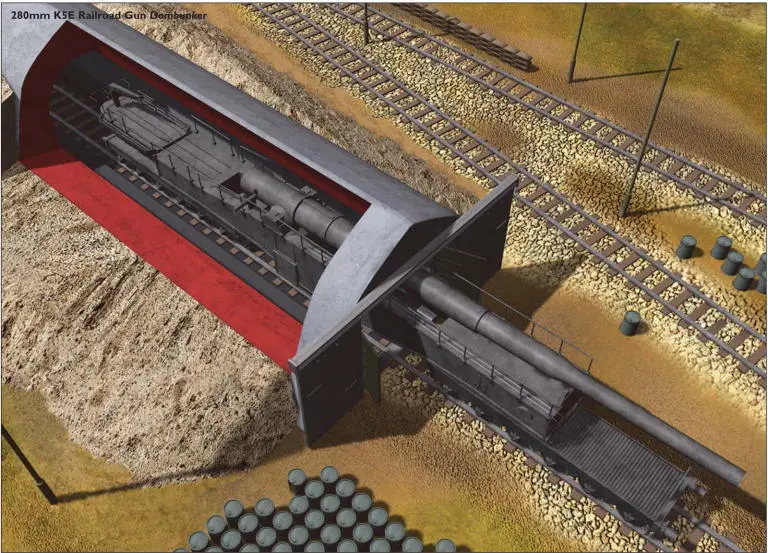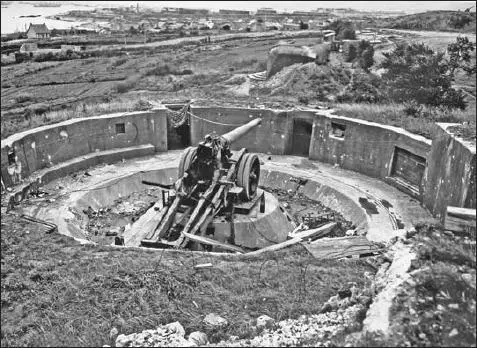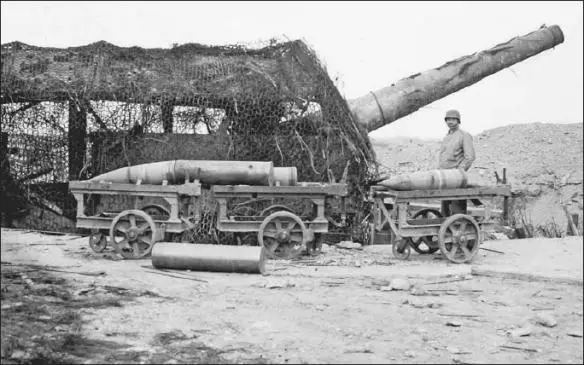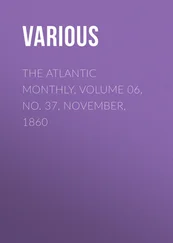The role of the Pas-de-Calais artillery batteries gradually evolved due to changing German war plans. As the possibilities for Operation Seelöwe dimmed in the winter of 1940, the role of the batteries gradually shifted to the naval interdiction role, challenging British shipping in the Channel. The railroad guns were gradually removed, especially once Hitler shifted his attention to Operation Barbarossa , the invasion of Russia scheduled for the summer of 1941. Construction of some of the large gun batteries initiated in the summer of 1940 continued, but without any particular priority and most of the larger Pas-de-Calais batteries were not completed until well into 1942. The only area to receive special attention was the Channel Islands, which attracted Hitler’s personal interest. He wanted the islands to be heavily defended to prevent their recapture by Britain and, in October 1941, authorized the heavy fortification of the islands as a key element to this process.

280mm K5E Railroad Gun Dombunker
Among the first type of fortifications built along the French coast was the Dombunker (cathedral bunker) so-called because of its resemblance to the arched shape of Gothic cathedrals. These were intended to protect three batteries of 280mm K5E railroad gun deployed to the Pas-de-Calais in the summer of 1940 and construction began in September 1940. This bunker was a simple reinforced tunnel, usually 80m in length and about 10m tall, though some bunkers such as the one at Hydrequent were shorter. Sites with these bunkers included Pointe aux Oies (EB.712), Fort Nieulay near Calais (EB.765), and Hydrequent (EB.713). Besides these bunkers, many of the railroad gun sites also were fitted with Vögele turntables to permit traverse of the weapon. (Artwork by Lee Ray)

A good example of a kettle gun emplacement typical of the initial construction in 1940–42, still part of the Cherbourg defenses in June 1944. The gun is a Saint-Chamond 155mm K220(f), a French World War I type widely used in the Atlantic Wall defenses. Most but not all of the kettle emplacements were rebuilt with full casemates by 1944. (NARA)
Coastal defense began to attract the attention of the Wehrmacht’s occupation forces in France due to Britain’s initiation of Commando raids along the Norwegian and French coasts. In February 1941, the army began proposing a policy directive which argued that a unified defense of the coast be established, with the army rather than the navy taking the lead role. This attempt was rebuffed by the OKW (Wehrmacht high command). which left the navy in charge of coastal defense artillery and the Luftwaffe in charge of flak protection of the coast, including naval flak batteries. Until the invasion of the Soviet Union in June 1941, there was a general policy against extensive fortification of the French coast for fear that it would confirm that the Wehrmacht’s intention had shifted from the invasion of Britain to the invasion of Russia.
British Commandos staged attacks against the Lofoten Islands off the northern Norwegian coast in March and December 1941. These prompted another Führer directive on December 14, 1941, which ordered the construction of a “new Westwall.” This order recognized that the western front was seriously short of troops due to the war in Russia, and it was proposed to substitute fortification for manpower. Light fortifications were authorized along endangered coastlines and permanent strongpoints at key points. Priority was given to the Norwegian coast, which Hitler felt was more vulnerable to such raids. Second priority went to the French coast, followed by the Dutch coast and Helgoland Bay in that order. Hitler also ordered the reinforcement of the coast defense with flak batteries that were assigned the dual role of anti-aircraft defense and potential use against landing craft. As a consequence of this order, the commander-in-chief West (OB West), Generalfeld-marschall Erwin von Witzleben, began to designate some of the key French ports as fortified areas ( Festungsbereichen ) to assign priorities for the eventual fortification effort. The Kriegsmarine was primarily responsible for the defense of the port itself, but the army was assigned the task of ensuring landward defense against possible airborne attacks.
British Commando raids continued in early 1942, including the daring raid on Bruneval to secure a Würzburg Radar. With the Wehrmacht bogged down in Russia, it seemed likely that the Western Front would remain on a defensive posture for some time to come. The evolving strategic situation led Hitler to issue Führer directive No. 40 on March 23, 1942, which laid the groundwork for the Atlantic Wall. The directive provided few specifics about the actual nature of the fortification, and it reaffirmed earlier priorities, with Norway and the Channel Islands being singled out for special attention. The ink was hardly dry on the new directive when it was followed a few days later by the dramatic raid on St. Nazaire, which managed to severely damage the vital dry docks there. This led Hitler to refocus the attention of the earlier directive, with a new emphasis on the defense of ports to prevent a repeat of the St. Nazaire raid. The first serious planning meeting for the Atlantic Wall occurred in May 1942 at Wehrwolf, the Führer headquarters at Vinnitsa, and attending the meeting was the new Reichsminister for Armaments Albert Speer, who had taken over the Organization Todt following the death of Fritz Todt in an airplane crash in February.
The Organization Todt was a paramilitary construction organization created in the 1930s to undertake major state projects including the autobahn and the Westwall defensive fortifications. Since the Wehrmacht had very modest construction capabilities, the Organization Todt was responsible for nearly all of the major fortification and military construction programs in France and the neighboring countries, including the gun batteries on the Pas-de-Calais, the new U-boat bunkers on France’s Atlantic coast, and the fortifications on the Channel Islands. The Wehrmacht’s Festungspionere Korps (Fortress Engineer Corps) under the Inspector of Engineers and Fortifications was responsible for designing and supervising the construction of fortifications by Organization Todt.
Serious construction efforts on the Atlantic Wall began in June 1942, and this was the first time that concrete consumption for the new fortifications exceeded that for the U-boat pens. On August 13, 1942, Hitler held a meeting with Reichsminister Speer and the senior OB West engineer staff to outline the strategic aim of the Atlantic Wall: “There is only one battle front [the Russian Front]. The other fronts can only be defended with modest forces… During the winter, with fanatical zeal, a fortress must be built which will hold in all circumstances… except by an attack lasting for weeks.” Hitler planned to defend the 3,800km (2,400 miles) of coastline from Spain to Norway using 15,000 bunkers and 300,000 troops with completion by May 1943, the earliest time an Allied invasion was likely. Hitler placed the emphasis on the defense of ports that were viewed as the most likely Allied objectives while the open beaches in between ports were assigned a lower priority. Hardly had this meeting been concluded when on August 17, 1942, the Allies struck at Dieppe with Operation Jubilee .

MKB Graf Spee of 5./MAA. 262 in Lochrist near Brest was armed with the Krupp 280mm SKL/40 M06 originally built for the old Brauschweig class of warships and previously located on one of the Friesian islands off the northern German coast before being transferred to Brittany in 1940. Three of the four guns were in open pits like this one, and only one in a large casemate. (NARA)
Читать дальше















